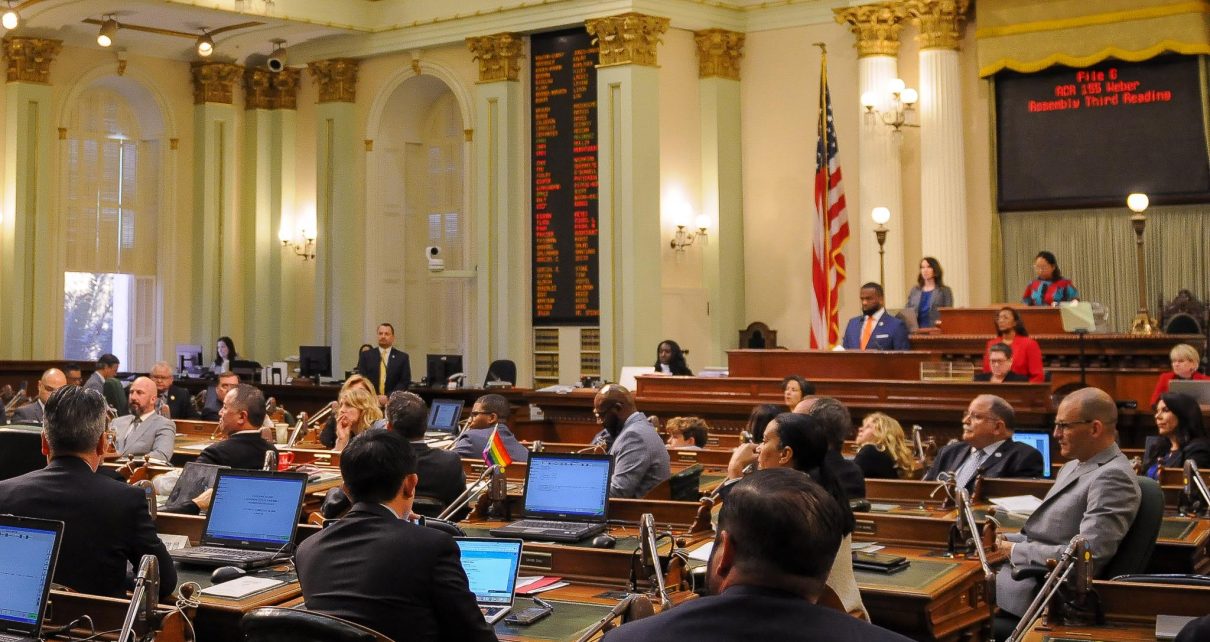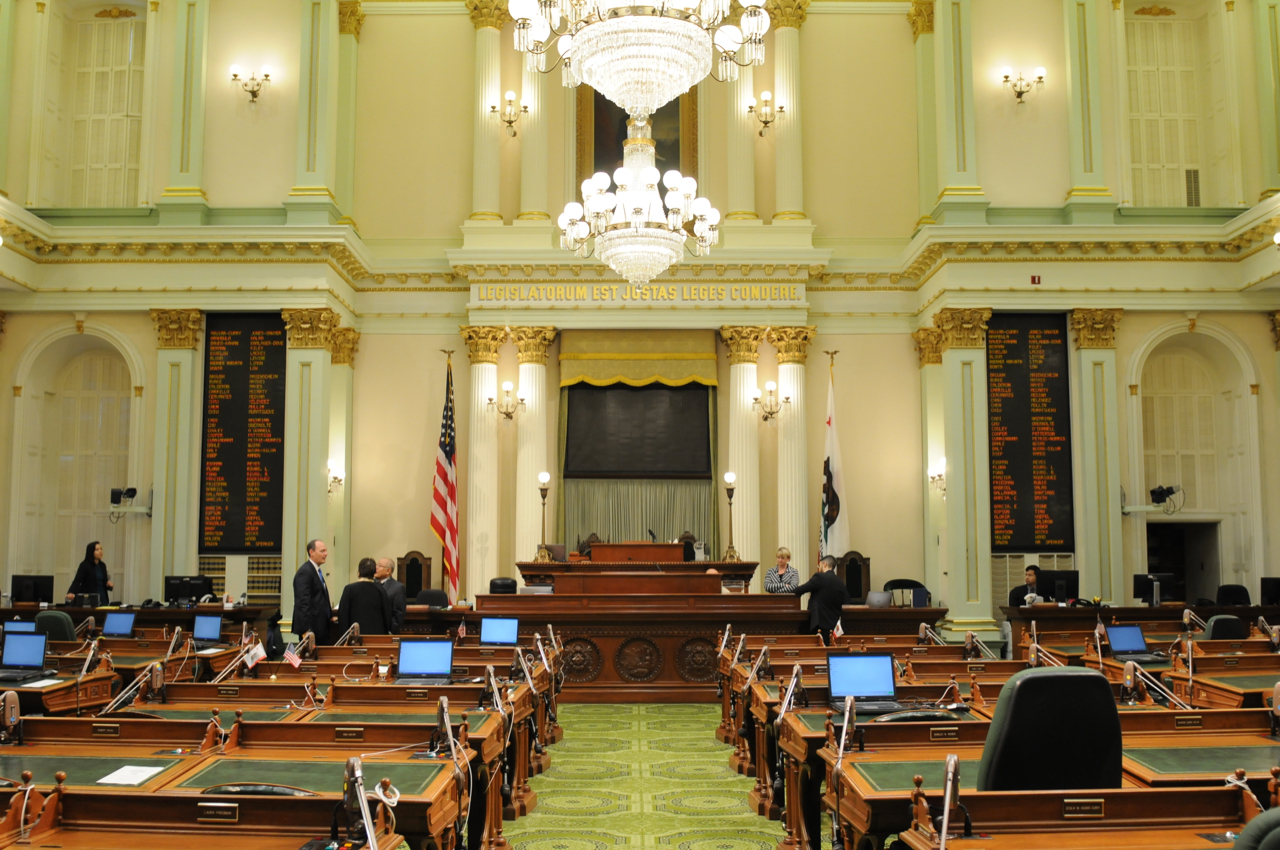
California State Assembly. (Photo: Kevin Sanders for California Globe)
Drafting Rules for Specific Types of Bills
Language is sometimes revised or stated differently depending on circumstances of the bill
By Chris Micheli, November 5, 2021 2:38 am
The purpose of this article is to provide some specific recommendations for drafting certain types of bills in California. This article covers appropriations bills, urgency bills, special statute bills, state mandated local program bills, tax levy bills, and double-jointing amendments. The standardized language and recommendations below are not formal rules. And, the language is sometimes revised or stated differently depending on the particular circumstances of the bill being drafted in this state.
Appropriations Bills
There are three major requirements for drafting bills that make an appropriation of funds.
First, in the Relating Clause, the following language must be included: “and making an appropriation therefor.”
Second, in the Legislative Counsel Digest, language similar to the following will be included (there needs to be a clear statement in the Digest that the bill contains an appropriation): The bill would appropriate __ (sum of money) from __ (identify source of funds) to the __ (identify recipient fund) for the purpose of __ (specify use of the funds).
Third, these Digest Keys will read: Appropriation: yes Fiscal committee: yes
In addition, consistent with the California Constitution, three statements need to be included in the actual statutory language: First, expenditure authority is being given to a state officer (this could be a program instead of an agency or state entity). Second, there is an ascertainable amount of funding (this usually includes where the money is coming from). Third, the funds are being appropriated for a particular purpose (this usually includes where the money is going).
Urgency Bills
There are four major requirements for drafting an urgency bill:
First, in the Relating Clause, the following language will be included: “and declaring the urgency thereof, to take effect immediately.”
Second, in the Legislative Counsel Digest, the following language will be used, typically at the end of the Digest: “This bill would declare that it is to take effect immediately as an urgency statute.”
Third, this vote key after the Digest will read: Vote: 2/3
Fourth, there will be a standalone section at the end of the bill (which is called a “plus” section) that includes the following language:
“This act is an urgency statute necessary for the immediate preservation of the public peace, health, or safety within the meaning of Article IV of the Constitution and shall go into immediate effect. The facts constituting the necessity are:
In order to __ (specify the urgency) as quickly as possible, it is necessary for this act to take effect immediately.”
Special Statute Bill
There are two major requirements for drafting a bill that proposes a special, rather than a general, statute:
First, in the Legislative Counsel Digest, the following language is included:
“This bill would make legislative findings and declarations as to the necessity of a special statute for __ (a short description).
Second, there will be a standalone section at the end of the bill (which is called a “plus” section) that includes the following language:
“The Legislature finds and declares that a special statute is necessary and that a general statute cannot be made applicable within the meaning of Section 16 of Article IV of the California Constitution because of the unique circumstances __ (described the unique nature and need for the bill).”
State-Mandated Local Program Bill
There are four major requirements (two included in the Digest) for drafting a bill that creates a state-mandated local program:
First, in the Legislative Counsel Digest, it is made clear that the state-mandated local program is related to the context in which the program is mandated. For example, the reader may see language such as: “By requiring local governments to do __ (specify the activity), this bill would impose a state-mandated local program.” Similar language that might be read could be: “By expanding the crime of __ (specify the type of crime), this bill would impose a state-mandated local program.”
Second, in the Digest as well, language similar to the following is included:
“The California Constitution requires the state to reimburse local agencies and school districts for certain costs mandated by the state. Statutory provisions establish procedures for making that reimbursement.
“This bill would provide that, if the Commission on State Mandates determines that the bill contains costs mandated by the state, reimbursement for those costs shall be made pursuant to the statutory provisions noted above.”
Note that this language is not always the same because it is dependent upon whether the state-mandated local program is reimbursable. The language set forth above is default reimbursement language. However, there is other form language used depending on the type of program.
Third, these Digest keys will read: Fiscal committee: yes Local program: yes
Fourth, there will be a standalone section at the end of the bill (which is called a “plus” section) that includes similar language to the following: “If the Commission on State Mandates determines that this act contains costs mandated by the state, reimbursement to local agencies and school districts for those costs shall be made pursuant to Part 7 (commencing with Section 17500) of Division 4 of Title 2 of the Government Code.”
Note here as well that the type of form language that is used in the plus section varies depending upon the type of state-mandated local program contained in the bill.
Tax Levy Bills
There are five major requirements for drafting a bill that is a tax levy:
First, in the Relating Clause, the following language will be included: “to take effect immediately, tax levy.”
Second, in the Legislative Counsel Digest, the following language will be used, typically at the end of the Digest: “This bill would take effect immediately as a tax levy.”
Third, these Digest keys will read: Vote: majority or 2/3 Fiscal committee: yes
Fourth, if the bill creates a new tax expenditure program, there will be a standalone section at the end of the bill (which is called a “plus” section) that includes similar language to the following: “It is the intent of the Legislature to comply with Section 41 of the Revenue and Taxation Code by __ (describing the goals and evaluation criteria for this new tax expenditure program).
Fifth, there will be a standalone section at the end of the bill (which is called a “plus” section) that includes the following language: “This act provides for a tax levy within the meaning of Article IV of the California Constitution and shall go into immediate effect.”
Double-Jointing Amendments
There are three major requirements for drafting a bill that requires double-jointing amendments (more commonly – and incorrectly – referred to as “chaptering-out amendments”):
First, in the Legislative Counsel Digest, similar language to the following will be used, typically at the end of the Digest: “This bill would incorporate additional changes to Section 2783 of the Labor Code proposed by AB 1506 to be operative only if this bill and AB 1506 are enacted and this bill is enacted last.”
Second, in the text of the bill, there will be a .5 section that combines the changes to a code section that are found in the two bills that have different language to the same code section.
Third, there will be a standalone section at the end of the bill (which is called a “plus” section) that includes similar language to the following: “Section 4.5 of this bill incorporates amendments to Section 2783 of the Labor Code proposed by both this bill and Assembly Bill 1506. That section of this bill shall only become operative if (1) both bills are enacted and become effective on or before January 1, 2022, (2) each bill amends Section 2783 of the Labor Code, and (3) this bill is enacted after Assembly Bill 1506, in which case Section 4 of this bill shall not become operative.”
Note that this language is not always the same because it is dependent upon specific circumstances. The language set forth above is default double-jointing language. In addition, there could be multiple code sections and multiple bills requiring more than one double-jointing amendment in bills.
There are other types of California bills that have unique drafting principles, but the above examples of legislation are the most common for bill drafters.
- Frequently Asked Questions about Other Constitutional Provisions and the Legislature - April 15, 2024
- Good Example of Municipal Affair Explanation - April 14, 2024
- Frequently Asked Questions about Joint Rule 10.5 and California Fiscal Bills - April 14, 2024




